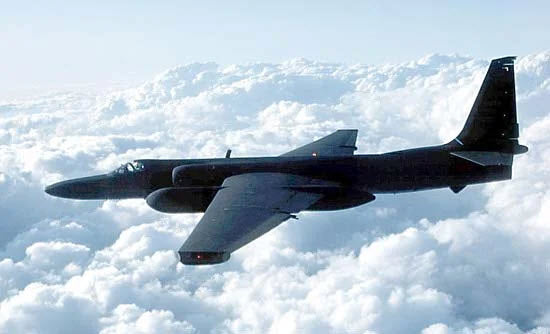Gary Powers and the U-2 Program

The wreckage of the U-2 flown by Gary Powers over the Soviet Union an downed near Sverdlovsk
The Aftermath Of The Downing
The CIA's first indication that something was wrong with Power's mission occurred even before he was due to land at Bodo. Remember, Powers and all U-2 pilots maintained strict radio silence during penetration missions.
The last communication with Powers was when he reached his penetration altitude of 66,000 feet and clicked his radio switch signaling the ops unit at Peshawar that everything aboard the aircraft was working and that the mission would proceed as planned.
As a result, once the flight started no one expected to hear anything from the pilot until he landed at his destination, in this case, Bodo, Norway.
Mission planners always laid out the flight route to avoid known SAM sites, but they had not known about the SAM site near Sverdlovsk and had they known would have planned a different route.
The US was monitoring Soviet radar tracking of aircraft over the Soviet Union and around 3:30 am Washington, DC time, noticed that the Soviets had discontinued radar tracking of the flight two hours earlier just southwest of Sverdlovsk.
This was the first indication that something had gone wrong with the mission. They assumed the worst but were surprised there was no word from the Soviet Union concerning the missing aircraft and pilot.
Operation MUDLARK
The CIA quickly established a new project called "Operation MUDLARK," and began to analyze available information and plan a course of action.
The first thought they had was that there was no way a pilot could survive an aircraft crash from above an altitude above 70,000 feet and survive.
They immediately prepared a standard cover story that the U-2 was on a weather flight by NASA (Nation Aeronautics and Space Administration). This cover story had been approved by President Eisenhower in 1956.
This story said that the aircraft was based in Adana, Turkey in order to conceal Pakistan's role in the mission. This story appeared in print on May 3rd, 1960.
In the story released by NASA from the base commander at Adana, it reported that a high-altitude weather airplane was missing on a flight inside Turkey and that "the pilot reported over the emergency frequency that he was experiencing oxygen difficulties."
This way NASA could claim that the pilot had lost consciousness and the aircraft wandered inside the borders of the Soviet Union before crashing.
Crafty Khrushchev
After almost four years of flights across the Soviet Union, the CIA had become overconfident and was not prepared for a "worse case" scenario.
So, the first word from the Soviet Union was an announcement by Soviet Premier Khrushchev announced to the Presidium of the Supreme Soviet that a US spy plane had been downed near Sverdlovsk. He made no mention of the fate of the pilot.
Immediately the US media became interested in the story, and on that same day, the State Department and NASA issued another statement continuing the "weather plane" cover story, adding that the pilot had become lost during a routine mission near the Caucasus Mountains.
Unfortunately for the US, the bad news continued to roll in. The US Ambassador to Moscow cabled a report to the State Department indicating that the pilot might still be alive after all.
On May 7, 1960, the worst-case scenario came true when Khrushchev revealed that the U-2 pilot was, in fact, alive and that he admitted to the mission to spy on the Soviet Union.

Khrushchev points to a table holding debris recovered from the U-2 wreckage
This revelation completely demolished the US cover story, and senior administration officials tried to figure out what to do in light of these disclosures.
Allen Dulles, Deputy Director of the CIA, offered to accept responsibility for the overflight and resign, but President Eisenhower didn't want to give the world the impression he was not in control of his administration.
So, on May 11, 1960, the President read a statement to the press accepting full responsibility for the U-2 mission, but left open the question of future overflights.
Of course, at the summit meeting in Paris which began less than a week later gave Khrushchev an opportunity to chastise the US and demand an apology from Eisenhower for the flight.
Eisenhower refused to apologize but did say the flights had been suspended and would not resume.
As soon as they learned that Powers was alive in Soviet custody, they immediately evacuated the British U-2 pilots from Adana to protect the secret of their involvement in these flights.
The Demise of the Program
On May 27, 1960, the Turkish Premier Adnan Menderes was removed by a coup, and because the new government was never made aware of this program they immediately refused to allow any U-2 flights from Adana.
All but one of the remaining U-2s at Adana were disassembled and flown back to the US on C-124 aircraft. The last U-2 remained inside a hangar at the Incirlik airbase in case the unit needed to be reactivated.
During the 44 months of the unit's active existence, 21 pilots flew the U-2s, including 4 RAF pilots. Those four RAF pilots were transferred to Edwards AFB until the end of the CIA program in 1974.
But the problems for the ELINT flights did not end there.
On July 1, 1960, a USAF RB-47 was shot down over international waters near the Soviet Union's Kola Peninsula.
See my blog post: A "Ferret Mission"
To make things even worse for the program, the Japanese Government, faced with growing anti-American sentiment and complaints in the press about the presence of "spy planes" on Japanese territory, asked the US to remove its U-2s.
The U-2s in Japan were disassembled and returned to the US on C-124s.
The last blow was when NASA decided to end its support for the cover story that the U-2s were conducting weather research.
The Fate Of Francis Gary Powers
The downed pilot, Francis Gary Powers, underwent extensive interrogation at the hands of the Soviets. His instructions from the CIA were vague and had been told to simply tell the Soviets whatever they wanted to know.
Nevertheless, Powers tried to conceal as much information as possible.
In order to get the maximum propaganda value from the U-2 affair, the Soviets put on an elaborate show trial for Powers. The trial began on August 17, 1960, and upon advice from his Soviet defense counsel, he told the court that he was sorry for his actions.

The trial of Francis Gary Powers by the Soviets
The sentence? Ten years "deprivation of liberty" with the first three years to be served in prison.
Over the next 18 months, confidential negotiations to obtain the release of Powers took place as the US explored the idea of exchanging convicted Soviet spy Rudolf Abel for Powers.
February 10, 1962, saw the exchange of Powers for Abel in the middle of the Glienecke Bridge connection between the East and West sections of Berlin.
Powers Returns Home
Upon his return, Powers was once again interrogated at the debriefing by the CIA.
Because Powers had not revealed as much information to the Soviets as he had, he was told that the CIA was proud of what he had done.
A board of Inquiry was set up, and on February 27, 1962, the board found that Powers had "complied with his obligations as an American citizen during this period."
He was awarded his back pay and was offered to be reinstated into the USAF.
In the meantime, Powers began working for Lockheed as a U-2 pilot until U-2 testing ended in September of 1969.
Earlier in 1969 he had published an account of his experiences on the U-2 project under the title "Operation Overflight."
After that, he flew a light airplane as a traffic reporter for a Los Angeles radio station and then a helicopter for a television station.
On August 1, 1977, both Powers and a cameraman for the station died when his helicopter crashed on the way to an assignment.

Gary Powers in front of the helicopter he flew for a television station
Power was 47 when he died.
The material I used for these three posts came from a CIA document that was declassified and which is available for anyone to read if the like. You can find ehe CIA report on the U-2 spy plane program.
I hope you enjoyed this trip through some of the history of aviation. If you enjoyed this trip, and are new to this newsletter, sign up to receive your own weekly newsletter here: Subscribe here:
Until next time, keep your eyes safe and focused on what's ahead of you, Hersch!







Leave a comment
This site is protected by hCaptcha and the hCaptcha Privacy Policy and Terms of Service apply.